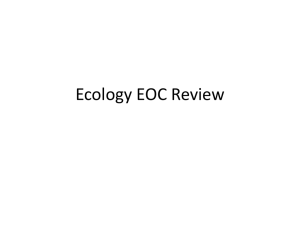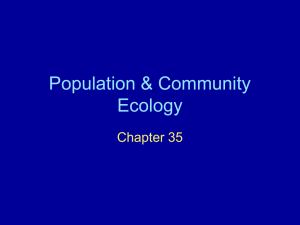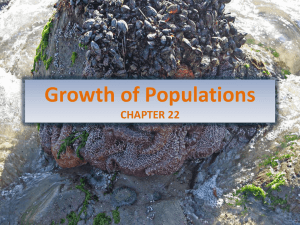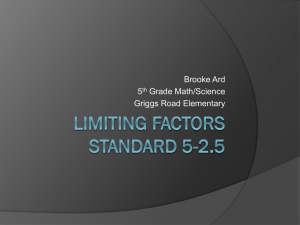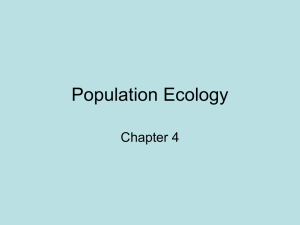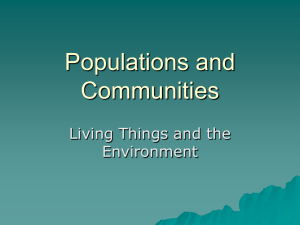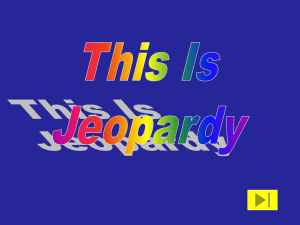Chapter 1 Environmental Science
advertisement
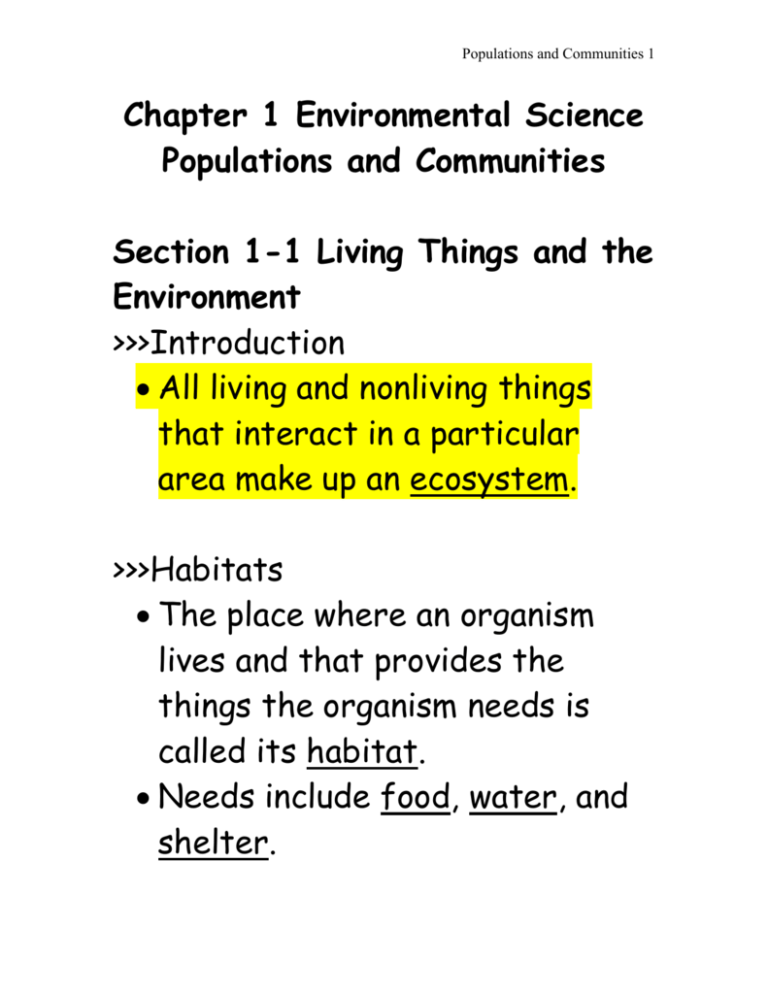
Populations and Communities 1 Chapter 1 Environmental Science Populations and Communities Section 1-1 Living Things and the Environment >>>Introduction All living and nonliving things that interact in a particular area make up an ecosystem. >>>Habitats The place where an organism lives and that provides the things the organism needs is called its habitat. Needs include food, water, and shelter. Populations and Communities 2 A single ecosystem may contain many habitats. >>>Biotic Factors The living parts of an ecosystem are called biotic factors. Examples of biotic factors in a prairie dog ecosystem are… o grass and other plants prairie dogs eat. o hawks, ferrets and other animals that hunt the prairie dog. o worms, fungi and bacteria that also live in the soil. Populations and Communities 3 >>>Abiotic Factors The nonliving parts of an ecosystem are called abiotic factors. Abiotic factors include o water o sunlight o oxygen o temperature o soil Water is needed by all living things. It is needed by algae and plants to make food. The process in which plants and algae make food using water, Populations and Communities 4 sunlight and carbon dioxide is called photosynthesis. Organisms that live on land get oxygen from the air. Fish and some other aquatic organisms get oxygen from the water around them. >>>Populations A species is a group of organisms that are physically similar and can reproduce with each other to produce fertile offspring. Examples of a population are… o All the prairie dogs in a prairie dog town. o All the daisies in a field. Populations and Communities 5 o All the pigeons in New York City. Not all populations live in the same size area. >>>Communities All the different populations that live together in an area make up a community. Smallest to Largest o Organism, Population, Community, Ecosystem In addition to a community of different species, an ecosystem includes abiotic factors. Populations and Communities 6 To be considered a community populations must live close enough together to interact. >>>What is Ecology? Ecology is the study of how living things interact with each other and with their environment. Scientists who study how living things interact with each other and the environment are called ecologists. Populations and Communities 7 Section 1-2 Studying Populations >>>Population Density Population density is the number of individuals in a specific area. >>>Determining Population Size Direct Observation—counting all the bald eagles that live along a river. Indirect Observation—Counting the number of nesting sites in an area. Sampling—counting the number of red maples in a small area to estimate the number in the entire forest. Populations and Communities 8 Mark-and-recapture study— Counting hawks with and without bands on their legs. Populations can change in size when new members enter the population or when members leave the population. The major way new individuals are added is through the birth of offspring. The number of births in a population in a certain amount of time is the birth rate. The major way individuals leave is by dying. Populations and Communities 9 The number of deaths in a population in a certain amount of time is death rate. If the birth rate is greater than the death rate, the population size increases. Immigration is moving into a population. Emigration is leaving a population. >>>Limiting Factors An environmental factor that prevents a population from increasing is called a limiting factor. Populations and Communities 10 Some limiting factors are food, space, and weather conditions. The largest population that an environment can support is called its carrying capacity. Space is often a limiting factor for plants. Weather limiting factors include… o Frost can kill organisms. o Floods and hurricanes can wash away nests and burrows. Start Notes Populations and Communities 11 Section 1-3 Interactions Among Living Things >>>Adapting to the Environment Natural Selection—process in which a species becomes better suited to its environment. Adaptation—characteristic that allows a species to live successfully in its environment. Niche—the way a species makes its living. >>>Competition The struggle between organisms to survive in a habitat with limited resources is called competition. Populations and Communities 12 Specializing in a certain area can help reduce competition. >>>Predation An interaction in which one organism kills and eats another organism is called predation. The organism that does the killing is the predator. The organism that is killed is the prey. If a prey population decreases, the population of its predator probably will decrease as well. Adaptations or the ability to adapt, allow prey to hide, and predators to find prey easier. Populations and Communities 13 >>>Symbiosis Symbiosis is a close relationship between two species that benefits at least on e of the species. Mutualism—both species benefit. Commensalism—one species benefits and the other is unharmed. Parasitism—one species benefits and the other species is harmed. In a parasitic relationship the organism that benefits is called a parasite. Populations and Communities 14 The organism the parasite lives on or in is called a host. Stop Notes Section 1-4 Succession Succession is the series of predictable changes that occur in a community over time. >>>Primary Succession In Primary succession no ecosystem previously existed. Because there is no soil or organisms, primary succession occurs over a long period of time. Examples where primary succession occurs are… Populations and Communities 15 o New islands formed by erupting volcanoes. o An area of rock exposed by melting ice. The first species to populate the area are called pioneer species. Typical pioneer species have spores or seeds that are easily carried by the wind. (Lichens and Mosses) These species break up the bare rock to form the soil that will support other plants. As the pioneer species die they fertilize the new soil with nutrients. Populations and Communities 16 >>>Secondary Succession Secondary succession occurs from a disturbance in an area with an existing ecosystem. Natural disturbances include fires, hurricanes and tornadoes. Human activities such as farming, logging and mining also cause secondary succession. Secondary succession occurs faster than primary succession. Species that appear as a result of succession depend on the type of biome created. Populations and Communities 17
